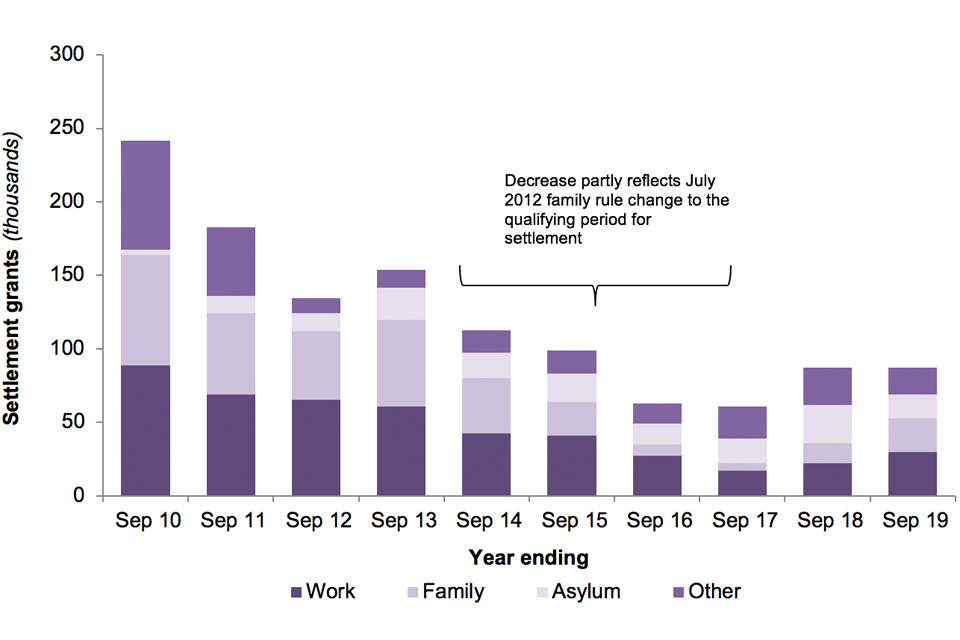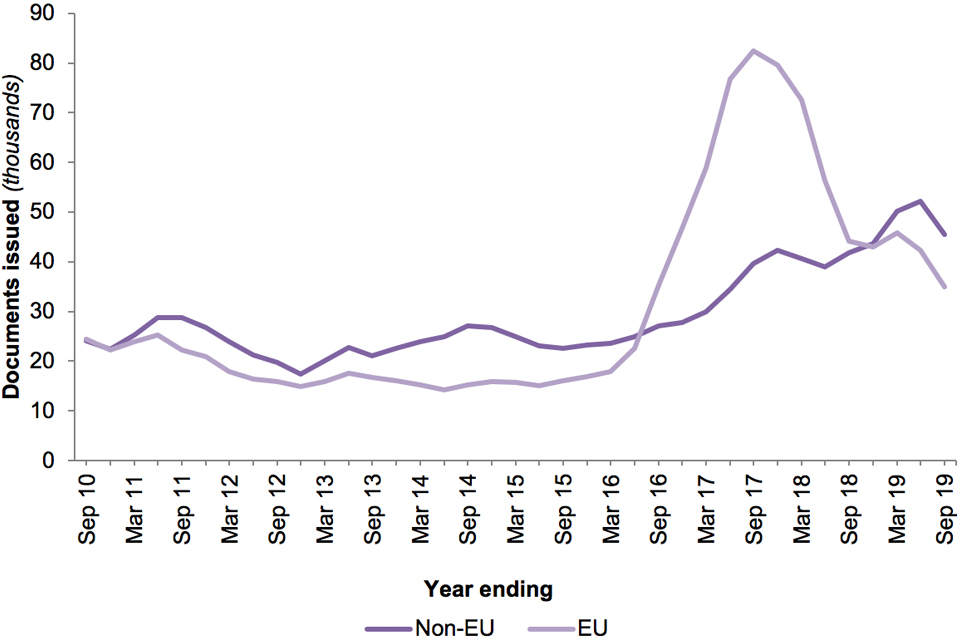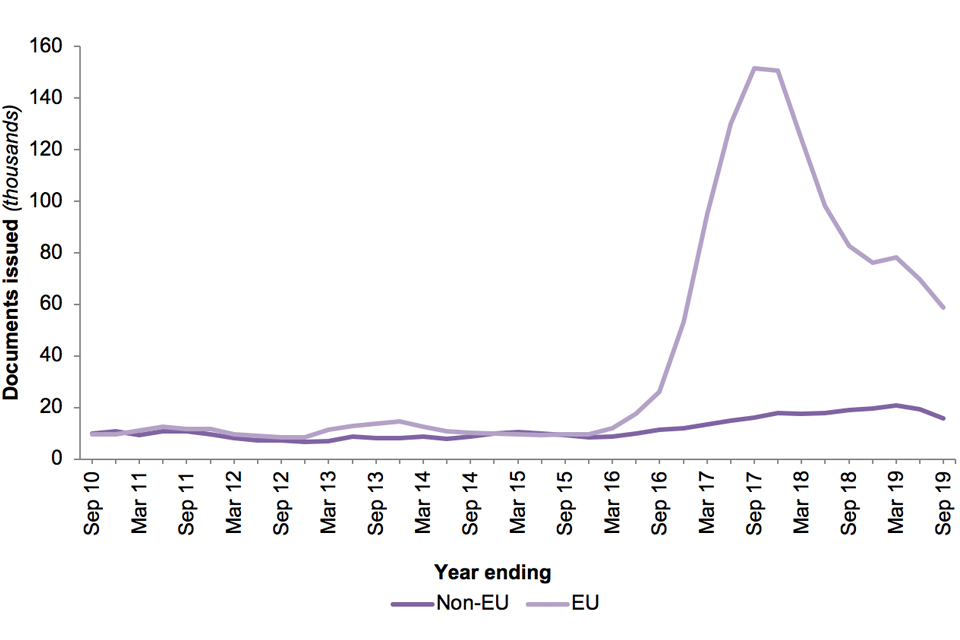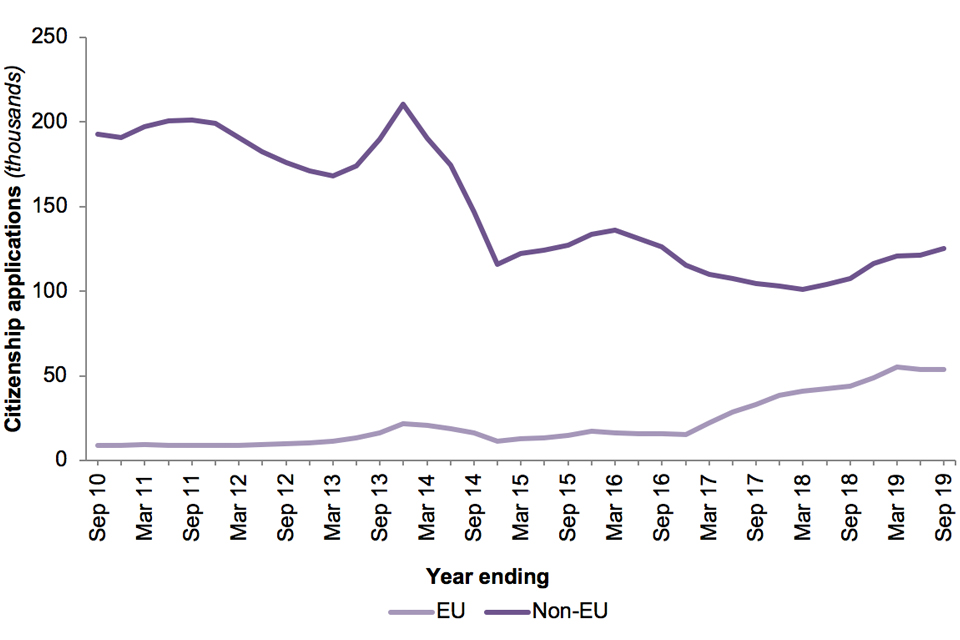How many people continue their stay in the UK?
Published 28 November 2019
Back to ‘Immigration Statistics, year ending September 2019’ content page.
This is not the latest release. View latest release.
Data in this section relate to the year ending September 2019 and all comparisons are with the year ending September 2018, unless indicated otherwise. A more detailed annual summary can be found in ‘Immigration statistics, year ending June 2019 second edition’.
This section contains data on:
- Decisions on applications for extensions of temporary stay in the UK from non-EEA nationals
- Decisions on applications for settlement from non-EEA nationals
- Residence documentation issued to EEA nationals and their family members
- Applications for British citizenship
The Home Office publishes monthly and quarterly experimental statistics on the EU Settlement Scheme, available on GOV.UK. The latest quarterly statistics was published on 7 November 2019 (for the period up to the end of September 2019) and the most recent monthly summary (for October 2019) was published on 14 November 2019.
1. Extension of temporary stay in the UK
There were 301,376 decisions on applications to extend a person’s stay in the UK (including dependants) in the year ending September 2019, 14% more than in the previous year. Of these, 283,079 were grants, 17% more than the previous year, representing a grant rate of 94%.
Table 1: Grants and refusals of extensions of temporary stay in the UK, by reason1,2
| Year ending | Total decisions | Total grants | Work | Study | Family | Other | Total refusals |
|---|---|---|---|---|---|---|---|
| September 2018 | 263,388 | 241,865 | 83,222 | 42,754 | 93,002 | 22,887 | 21,523 |
| September 2019 | 301,376 | 283,079 | 103,325 | 43,483 | 111,813 | 24,458 | 18,297 |
| Change (latest year) | +37,988 | +41,214 | +20,103 | +729 | +18,811 | +1,571 | -3,226 |
| Percentage change | +14% | +17% | +24% | +2% | +20% | +7% | -15% |
Source: Extensions - Exe_D01
Notes:
- The latest increases in family extensions are likely to reflect a longer residence eligibility period before it is possible to apply to stay in the UK permanently (settlement), and a requirement to complete further periods of temporary leave, both implemented under family Immigration Rules from 9 July 2012. The rules in place before 9 July 2012 allowed spouses to apply for settlement after completion of a single two-year ‘probationary period’. Further details on the rule changes are in the user guide.
- Includes cases where the category of grant has not been recorded.
Family was the most common route in which people extended, with 111,813 family-related grants of extensions in the year ending September 2019, a 20% increase compared with the previous year. Pakistani, Indian, Nigerian, Bangladeshi and Ghanaian nationals accounted for just over half (51%) of all family-related extensions granted over the year.
There were 103,325 extensions in the work category in the year ending September 2019, a 24% increase compared with the previous year. The majority (82%) were in Skilled (Tier 2) work categories. Indian nationals were granted the highest number of all work-related extensions during the year (42,350 or 41% of the total).
Study-related extensions granted in the year ending September 2019 have remained stable (43,483). The nationalities most likely to extend their stay in the UK are broadly consistent with the nationalities granted Entry clearance visas, with nationals of China accounting for over half (57% or 24,686) of study-related extensions granted during the year.
Data for 2018 (latest available) show that 75% of main applicants extending in work categories were previously on a work route, but 15% had previously been studying. The vast majority (97%) of main applicants extending for study-related reasons were already on the study route and are therefore, extending their course of study or changing to another course.
The increase in family-related extensions reflects the introduction of the Family Life (10-year) route and a longer residence eligibility period before it is possible to apply to stay in the UK permanently (settlement). Individuals on family routes are required to obtain an extension every 2.5 years until they are eligible to apply for settlement. These changes were introduced as part of the new family Immigration Rules from 9 July 2012.
2. Settlement
There were 91,023 decisions on applications for settlement in the UK from non-EEA nationals in the year ending September 2019, similar to the previous year. Of these, 87,441 (96%) resulted in a grant.
Trends in numbers applying for settlement will in part reflect policies and patterns of migration some years previously. In the latest year there were increases in settlement for:
- Family reasons (up 71% to 22,907), reflecting family rule changes in July 2012 that increased the qualifying period for settlement from 2 to 5 years. Individuals on a 5-year route to settlement following the rule change are now becoming eligible to apply (further information about the rules changes are available at: ‘Family and private life immigration rule changes 9 July 2012’)
- Skilled (Tier 2) work, up 45% (6,809) to 21,816 reflecting an increase in visas granted 5 years earlier
There were decreases in settlement grants following a grant of leave to stay following an asylum claim (down 38% to 16,121), and to those previously in the UK for other reasons, primarily long residence or discretionary leave (down 28% to 18,423).
Table 2: Grants and refusals of settlement in the UK, by reason1,2
| Year ending | Total decisions | Total grants | Work | Asylum | Family | Other | Refusals |
|---|---|---|---|---|---|---|---|
| September 2018 | 91,248 | 87,294 | 22,485 | 25,814 | 13,379 | 25,616 | 3,954 |
| September 2019 | 91,023 | 87,441 | 29,990 | 16,121 | 22,907 | 18,423 | 3,582 |
| Change: latest 12 months | -225 | +147 | +7,505 | -9,693 | +9,528 | -7,193 | -372 |
| Percentage change | 0% | 0% | +33% | -38% | +71% | -28% | -9% |
Source: Settlement table se 02 q
Notes:
- The number of decisions in a given year can be affected by changes in casework resource allocation. Such fluctuations can be examined in more detail in the quarterly data that are available in the published Settlement tables.
- Includes grants on the basis of Long Residence and grants on a discretionary basis. Also includes a small number of cases where the category of grant has not been recorded.
Figure 1: Grants of settlement in the UK, by reason1, years ending September 2010 to 2019

Source: Settlement table se 02 q
Notes:
- Reason relates to type of leave held immediately prior to being granted settlement.
3. EEA nationals and their family members
Under European law, EEA nationals and their dependants do not currently need to obtain documentation confirming their right of residence in the UK.
EEA nationals can apply for registration certificates and documents certifying permanent residence in the UK. Their family members (who are non-EEA nationals) can apply for residence and permanent residence cards. These act as confirmation of their right to stay in the UK. There is no requirement to apply for a residence card as a family member but it can help residence card holders to prove their status in certain circumstances.
EEA nationals only need to apply for a document certifying permanent residence if they want to either apply for British citizenship or sponsor their partner’s visa application under the Immigration Rules.
EEA residence documents, including registration certificates, registration cards, documents certifying permanent residence and permanent residence cards, will not be valid after 31 December 2020. Since 30 March 2019, EU and EEA nationals resident in the United Kingdom, along with their non-EEA family members can apply to the EU Settlement Scheme to continue living in the UK.
The Home Office publishes high-level progress information on the EU Settlement Scheme through monthly Experimental Statistics, EU Settlement Scheme monthly statistics, October 2019. More than 2.4 million applications were received up to 31 October 2019. A more detailed quarterly report, EU Settlement Scheme quarterly statistics, September 2019, was most recently published on 7 November 2019.
3.1 Registration certificates and registration cards
In the year ending September 2019, there were 80,442 registration certificates and registration cards issued to non-EEA family members, down 6% on the previous year. This followed the large increases seen in the period immediately following the referendum on membership of the EU in June 2016. The current level remains higher than before the referendum.
There were 21% fewer registration certificates issued to EU nationals (down 9,249 to 34,973), although this remains higher than pre-EU referendum periods.
Documents issued to non-EU nationals increased by 9% to 45,469 when compared to the previous year, continuing a gradual increase since June 2015.
Figure 2: Number of EEA1 residence documents issued to EU and non-EU2 nationals, years ending September 2010 to 2019

Source: EEA table ee 02 q
Notes:
- The EEA consists of the 28 countries of the EU, plus Iceland, Liechtenstein and Norway. See the user guide for a list of countries within the EU.
- Non-EU includes non-EEA family members of EEA nationals and small numbers of EEA nationals from Iceland, Lichtenstein and Norway, and Swiss nationals.
3.2 Documents certifying permanent residence and permanent residence cards
There were 74,541 documents certifying permanent residence and permanent residence cards issued in the year ending September 2019, 27% fewer than the previous year (down 27,127). Since the EU referendum, trends for EU and non-EU nationals have differed.
Although documents issued to EU nationals have fallen since the peak of 151,521 in the year ending September 2017, current levels remain considerably higher than prior to the EU referendum, at 58,633 in the latest year.
Documents issued to non-EEA nationals have gradually increased since 2016 but the number fell by 17% to 15,878 in the latest year.
Figure 3: Number of EEA1 permanent residence documents issued to EU and non-EU2 nationals, years ending September 2010 to 2019

Source: EEA table ee 02 q
Notes:
- The EEA consists of the 28 countries of the EU, plus Iceland, Liechtenstein and Norway. See the user guide for a list of countries within the EU.
- Non-EU includes non-EEA family members of EEA nationals and small numbers of EEA nationals from Iceland, Lichtenstein and Norway, and Swiss nationals.
4. Citizenship
4.1 Applications for British citizenship
There were 179,380 applications for British citizenship in the year to September 2019, 18% more than the previous year.
In the last 12 months, applications for citizenship by EU nationals increased by 22% to 53,917. EU nationals now account for 30% of all citizenship applications, compared with 11% in 2016. Increases in citizenship applications from EU nationals in the last 3 years are likely to reflect more people seeking to confirm their status following the EU referendum.
Applications made by non-EU nationals increased by 17% in the most recent year to 125,463, following falls in the previous 2 years.
Figure 4: Applications for British citizenship from EU and non-EU nationals1,2, years ending September 2010 to 2019

Source: Citizenship table cz 01 q a
Chart notes:
- Series are based on current EU membership; for example, Croatians are included in the EU total throughout the time series.
- The increase in applications made in 2013 may have reflected people anticipating the rule change to the English language element of the ‘Life in the UK’ test as of 28 October 2013. See the Policy and Legislative Changes Timeline for details.
4.2 Grants of British citizenship
There were 153,742 grants of British citizenship in the year ending September 2019, 5,009 or 3% fewer than the previous year. The most recent peak was in 2013, prior to the change to the English language element of the ‘Life in the UK’ test, when there were 208,095 grants of citizenship. The number of applications, and therefore grants, fell following the change and has remained relatively stable since.
There were 48,463 grants of UK citizenship to former EU citizens, a 2% increase from the preceding year but more than three and half times the level prior to the EU referendum. Polish nationals were the top EU nationality being granted citizenship in the latest year (9,063), followed by Romanian (5,643) and Italian (5,631) nationals.
Grants to former nationals of non-EU countries fell by 5% in the year ending September 2019 to 105,279.
More than half (53%) of grants of British citizenship in the last year were naturalisations on the grounds of 5 or more years’ residence in the UK under section 6(1) of the British Nationality Act 1981 (‘residence’), although grants in this category fell by 9%. Grants of citizenship following marriage increased by 13% to 27,127.
Table 3: Outcomes of citizenship applications, by category1
| Year ending | Total decisions | Total grants | Residence | Marriage | Children | Other | Refusals & withdrawals |
|---|---|---|---|---|---|---|---|
| September 2018 | 167,619 | 158,751 | 89,536 | 23,951 | 36,796 | 8,468 | 8,868 |
| September 2019 | 161,926 | 153,742 | 81,389 | 27,127 | 34,311 | 10,915 | 8,184 |
| Change: latest year | -5,693 | -5,009 | -8,147 | +3,176 | -2,485 | +2,447 | -684 |
| Percentage change | -3% | -3% | -9% | +13% | -7% | +29% | -8% |
Source: Citizenship table cz 02 q
Notes:
- ‘Other grounds’ includes Entitlement and Discretionary registration as an adult, Entitlement and Discretionary registration on other grounds, and registration under Section 5 of the British Nationality Act 1981. See Citizenship table cz 07 and the User Guide to Home Office Immigration Statistics for more detail.
5. About these statistics
The statistics in this section refer to individuals who have leave to remain in the UK who wish to extend, or make permanent, their right to remain in the UK.
Data in this section should be viewed in the context of wider policy and legislative changes, which can impact the number of applications and decisions. They should also consider the availability and allocation of resources within the Home Office, which can affect the number of decisions made in a given period. For example, fewer citizenship decisions were made in 2015 when UKVI resources were used to assist HM Passport Office.
The statistics should not be used to make inferences about the size of the non-British population in the UK. The data do not show whether, or for how long, an individual remains in the UK once their right to remain has been extended or made permanent. Statistics on resident foreign populations in the UK are published by ONS.
5.1 Extension of temporary stay in the UK
Extensions of temporary stay in the UK relate to individuals inside the UK extending or changing the status of their right to stay in the UK. An individual is required to apply for an extension or change in status before their existing permission to enter or stay in the UK expires.
The statistics in this section show the number of grants and refusals in a given year on applications for extension of temporary stay in the UK. One individual may have made multiple applications for an extension, so may account for multiple decisions in a given period. Data in this section include dependants and take account of the outcomes of reconsiderations and appeals.
The statistics do not show the number of people applying to extend their temporary stay in the UK, nor do they show how long an individual stayed in the UK following their extension.
The statistics in the previous immigration category of students granted an extension were estimated for 2013, 2014, 2015, 2016 and 2018. Data for 2017 are unaffected.
Further information on the statistics in this section can be found in the extension section of the user guide.
5.2 Settlement
Settlement can be granted to individuals, subject to immigration control, to allow them to work, study and travel into and out of the UK without restriction. To be granted settlement, individuals generally must have lived in the UK for a certain length of time in a qualifying category. Those granted settlement can access state benefits and register their UK-born children as British citizens. It does not entitle the individual to a British passport (which requires British citizenship) or to vote in a general election (which requires British, Commonwealth or Irish Republic citizenship).
The statistics in this section show the number of grants and refusals in a given year on applications for settlement in the UK. They take account of the outcomes of reconsiderations and appeals.
The data on settlement refusals relate to cases where settlement was refused and no other form of leave was granted. Cases where settlement was refused but an extension was granted instead (for example where an individual has not met the qualifying period for settlement) will not be included in the refusal figure.
Individuals who leave the UK for more than 2 years may have their settlement status revoked, except in exceptional circumstances. The statistics do not differentiate between those granted settlement for the first time and those granted settlement multiple times.
5.3 EEA nationals and their family members
EEA and Swiss nationals have freedom of movement throughout the EEA. Non-EEA nationals who are dependants of EEA national residents in the UK can share their residence if they satisfy certain conditions. See the user guide for details.
The statistics in this section show the number of registration certificates and registration cards issued, and the number of documents certifying permanent residence and permanent residence cards issued.
After 12 November 2015, a person applying for citizenship who is claiming to have permanent residence as an EEA national, or the family member of an EEA national, has been required to provide a permanent residence card or a document certifying permanent residence as evidence that they meet the requirement to be free of immigration time restrictions. These rule changes, along with EEA nationals’ response to perceived uncertainty following the 2016 EU referendum, are likely to have contributed to the steep increase in demand for EEA residence documentation during 2016 and 2017.
Variations in numbers of decisions can be affected by changes in resources and the mix of cases, as well as policy changes and application levels in earlier periods.
More information about applying for residence documentation and how the status of EU citizens in the UK will be secured after the UK leaves the EU is available at EU, EEA and Commonwealth citizens.
Figures on applications received and cases currently outstanding in the European casework route (along with other information such as percentage processed within service standards) can be found in ‘In-country migration data’ on GOV.UK.
5.4 Citizenship
British citizens can live and work in the UK free of any immigration controls. They can apply for a British passport, register to vote in all forms of election and referenda, and share in all the other rights and responsibilities of their status.
Dual citizenship (also known as dual nationality) is allowed in the UK. This means people can be a British citizen and a citizen of other countries.
If someone is not already a British citizen based on where and when they were born, or their parents’ circumstances, they can apply to become one.
The statistics in this section show the number of applications for British citizenship. Data on the number of grants of citizenship are available in the associated data tables.
In May 2019, the Home Office published the Migrant journey: 2018 report’, which explores changes in non-EEA migrants’ visa and leave status as they journey through the UK’s immigration system.
6. Data tables
Data referred to here can be found in the following tables:
- Extensions summary tables
- Detailed extensions datasets
- Settlement tables
- Citizenship tables
- European Economic Area (EEA) tables
We welcome your feedback
If you have any comments or suggestions for the development of this report, please provide feedback by emailing MigrationStatsEnquiries@homeoffice.gov.uk. Please include the words ‘PUBLICATION FEEDBACK’ in the subject of your email.
See section 7 of the ‘About this release’ section for more details.
